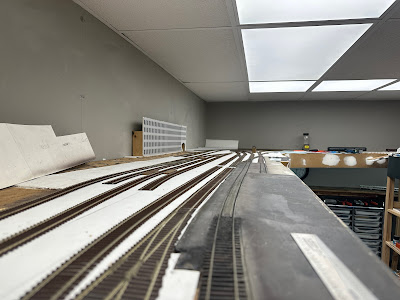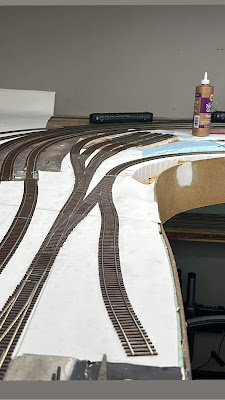These are KV Models compromise joint bars. On the left is Microengineering Code 55 track, and the right is a Peco Code 83 curved turnout. The KV Models joint bars can be soldered to the rail, so I figured I could go a step further and eliminate the rail joiners at the same time.
You can also see one of the reasons I personally don't care for Peco track and turnouts - their tie plates and spikes are significantly larger (out-of-scale) than Microengineering. I'll be able to reduce this with painting and weathering and, of course, it would be less noticeable on a layout that is all Peco track.
Although I'm not doing this everywhere, I am using the approach throughout New Britain Yard and other newly replaced track that will be close to the fascia. Especially in cases like this where the rail code is different.
The basic process I'm using now:
- Use a Dremel with a wire brush to polish the backs of the joint bars while still on the fret.
- Tin the backs of the joint bars while still on the fret.
- Clean/use a Dremel with a brush to polish the rail.
- Apply flux to both sides of the rail.
- Apply solder paste to both sides of the rail.
- Apply solder paste to the back of the joint bars while still on the fret.
- Cut the joint bars from the fret and apply to both sides of the rail.
- I lightly squeeze the joint bars with a pair of tweezers in place, then touch the iron to the top of the rail.
I polished and tinned the entire fret at one time. I apply the solder paste only to joint bar just prior to cutting off the fret to install. The flux/solder paste is sufficient to hold the joint bar in place in the web of the rail, I squeeze them just to ensure they are securely soldered to the rail web. The extra tie in the photo above was to raise the Code 55 rail into the correct position. In addition to the shorter rail, Microengineering ties are shorter than Peco.
This is the only Peco turnout on the layout, and I have four Walthers turnouts too. Despite the enormous flexibility in modifying Microengineering turnouts, they can't be used for everything. The track geometry here needed a 28" radius diverging track, which is a close match for the Peco turnout. The Walthers ones are also on this track around the top of the helix for similar reasons.


%200740%20and%200745%20in%20gold%20and%20silver%20gray%20pinstripes.jpg)








.jpg)



